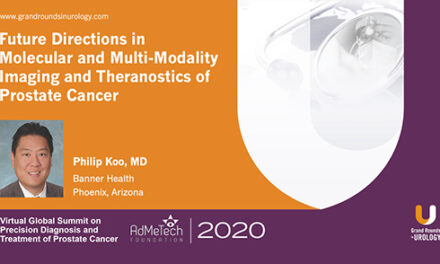Sigrid V. Carlsson, MD, PhD, MPH, presented “Screening and Prevention of Prostate Cancer 2021 (Part 2): Who Needs a Biopsy?” for the Grand Rounds in Urology audience in June 2021.
How to cite: Carlsson, Sigrid V. “Screening and Prevention of Prostate Cancer 2021 (Part 2): Who Needs a Biopsy?” June 2021. Accessed Dec 2024. https://dev.grandroundsinurology.com/screening-and-prevention-of-prostate-cancer-2021-part-2-who-needs-a-biopsy/
Screening and Prevention of Prostate Cancer 2021 (Part 2): Who Needs a Biopsy? – Summary:
In part 2 of a 3-part series, Sigrid V. Carlsson, MD, PhD, MPH, Assistant Attending Epidemiologist at Memorial Sloan Kettering Cancer Center, goes over her 5 Golden Rules for prostate cancer testing, which are intended to minimize overdiagnosis and overtreatment while also making sure that significant disease is not missed. Rule 1 is to get consent and engage in shared decision-making with patients. Dr. Carlsson notes that this can sometimes be difficult since the numerous decision aids available are often difficult to use and understand. The second rule is not to screen men who will not benefit, for instance, older men with multiple comorbidities and short life expectancies. Dr. Carlsson does observe, however, that instituting an age cutoff does not necessarily make sense, and that physiologic assessment of life expectancy may be a more useful metric. In rule 3, Dr. Carlsson advises clinicians not to biopsy patients without a compelling reason, since prostate biopsies may lead to infectious complications and hospitalization. She then lays out the options for risk stratification, such as risk calculators, biomarker tests, and MRI. Rule 4 recommends against treating low-risk disease since, as Dr. Carlsson explains, active surveillance is a safe strategy over longer follow-up for appropriately selected patients with Grade Group 1 prostate cancer when following a well-defined monitoring plan. Finally, rule 5 exhorts clinicians to send patients who require treatment to a high-volume provider. This is key, Dr. Carlsson argues, since evidence shows that there is a large degree of heterogeneity among surgeons regarding functional and oncological outcomes after prostatectomy, and it takes approximately 250 surgeries for a surgeon to really master the procedure.
Part 1 of this series was published last week and can be viewed here. Part 3 will be published on GRU next week
ABOUT THE AUTHOR
Sigrid Carlsson, MD, PhD, MPH, is an Assistant Attending Epidemiologist at Memorial Sloan Kettering Cancer Center (MSKCC) with 15 years of prostate cancer research experience and over 100 publications. Her PhD thesis stemmed from the world’s largest study of prostate cancer screening, the European Randomized Study of Screening for Prostate Cancer (ERSPC), which investigated how quality of life was affected by screening and treatment. Before pursuing postdoctoral studies in urologic oncology at MSKCC, Dr. Carlsson was a physician in Sweden. She obtained an MPH degree from Harvard T.H. Chan School of Public Health.
Currently, Dr. Carlsson’s research focuses on developing risk-stratified approaches to screening, diagnosis, treatment, and follow-up of prostate cancer patients. She is also the PI of a study funded by the Patty Brisben Foundation to improve the method of asking questions about women’s sexual health. She is a co-investigator on a multi-center study funded by Movember (PI: Andrew J. Vickers, PhD) that evaluates the impact of survivorship care plans and navigation tools on patients with prostate cancer after radiotherapy. She is a co-investigator on two NIH-funded research projects, one of which investigates biomarkers and risk stratification in localized prostate cancer (PI: Hans Lilja, MD, PhD). The second project is focused on developing models to improve prostate cancer outcomes across diverse populations (PI: Ruth Etzioni, PhD).





